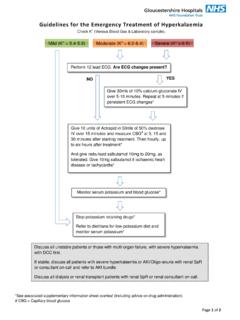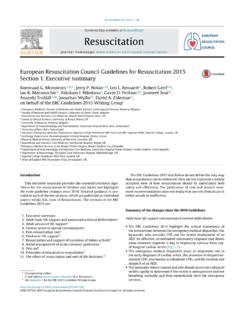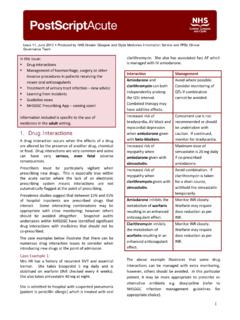Transcription of Name of the Medicine - Medsafe Home Page
1 1 Sodium Bicarbonate Sodium bicarbonate % w/v injection BP Name of the Medicine Sodium Bicarbonate BP The molecular weight of the compound is and the CAS registry number is 144-55-8. The molecular formula is NaHCO3. Presentation Sodium Bicarbonate Injection is a sterile solution containing 84 mg/mL sodium bicarbonate in water for injections. The excipients are disodium edetate, sodium hydroxide (for pH adjustment) and water for injections. The pH is approximately Each mL of solution contains mg of sodium bicarbonate which gives mg (or 1 mmol or 1 mEq) of sodium and mg (or 1 mmol or 1 mEq) of bicarbonate. Uses Sodium bicarbonate is a systemic alkalinizing agent which, when given intravenously, will increase plasma bicarbonate, buffer excess hydrogen ion concentration, raise blood pH and reverse the clinical manifestations of acidosis. Sodium bicarbonate dissociates in water to provide sodium and bicarbonate ions (HCO3 ).
2 Sodium is the principal cation of the extracellular fluid and plays a large part in the therapy of fluid and electrolyte disturbances. Bicarbonate is a normal constituent of body fluids and the normal plasma level ranges from 24 to 31 mmol/L. Acid-base homeostasis exerts a major influence on protein function, thereby critically affecting tissue and organ performance. Systemic arterial pH is maintained by extracellular and intracellular chemical buffering together with respiratory and renal regulatory mechnism. The control of arterial carbon dioxide (CO2) tension (PaCO2) by the central nervous system and respiratory systems and the control of the plasma bicarbonate by the kidneys stabilize the arterial pH by excretion or retention of acid or alkali. Under most circumstances, CO2 production and excretion are matched, and the usual steady-state PaCO2 is maintained at 40 mmHg. The kidneys regulate plasma HCO3 through three main processes: (1) "reabsorption" of filtered HCO3 , (2) formation of titratable acid, and (3) excretion of NH4+ in the urine.
3 The kidney filters approximately 4000 mmol of HCO3 per day. To reabsorb the filtered load of HCO3 , the renal tubules must therefore secrete 4000 mmol of hydrogen ions. Between 80 and 90% of HCO3 is reabsorbed in the proximal tubule. The distal nephron reabsorbs the remainder and secretes protons, as generated from metabolism, to defend systemic pH. While this quantity of protons, 40 to 60 mmol/d, is small, it must be secreted to prevent chronic positive H+ balance and metabolic acidosis. This quantity of secreted protons is represented in the urine as titratable acid and NH4+. Metabolic acidosis in the face of normal renal 2 function increases NH4+ production and excretion. NH4+ production and excretion are impaired in chronic renal failure, hyperkalaemia , and renal tubular acidosis. The management of serious acid-base disorders always demands precise diagnosis and treatment of the underlying disease, and in certain circumstances, it requires steps to combat the deviation in systemic acidity itself.
4 Administration of sodium bicarbonate will increase the plasma HCO3 concentration and help restore the plasma pH within the normal range (pH ). Changes in acid-base balance also stimulate compensatory ion-exchange mechanisms. When the extracellular hydrogen ion concentration increases, as in acidosis, there is a redistribution of potassium ions from intracellular to extracellular fluid. Administration of sodium bicarbonate can cause a redistribution of potassium ions into cells in patients with acidosis, by increasing the plasma pH. The urinary pH will be increased by sodium bicarbonate in patients with normal renal function. Alkalinising the urine can increase the solubility of certain weak acids, and can increase the ionisation and urinary excretion of lipid-soluble organic acids ( phenobarbitone, salicylates). Metabolic Acidosis Metabolic acidosis is characterized by a primary decrease in serum bicarbonate (HCO3-) concentration to below 24 mmol/L and a compensatory decrease in the CO2 concentration.
5 It occurs from either loss of bicarbonate (HCO3-) or addition of hydrogen ion (H+). Bicarbonate loss generally occurs through the kidneys or the bowel. Acidosis from decreased acid renal excretion generally is slow to develop. In contrast, acidosis from increased acid production, as in lactic acidosis or ketoacidosis, can exceed maximal renal excretion and cause a rapidly developing, severe acidosis. Standard texts and institutional protocols should be consulted on the aetiology and management of metabolic acidosis. Indications Sodium bicarbonate is used as an alkalinising agent in the treatment of metabolic acidosis which may occur in many conditions including diabetes, starvation, hepatitis, cardiac arrest, shock, severe dehydration, renal insufficiency, severe diarrhoea, Addison's disease or administration of acidifying salts ( excessive sodium chloride, calcium chloride, ammonium chloride). Sodium bicarbonate is also used to increase urinary pH in order to increase the solubility of certain weak acids ( cystine, sulphonamides, uric acid) and in the treatment of certain intoxications ( methanol, phenobarbitone, salicylates) to decrease renal absorption of the drug or to correct acidosis.
6 Dosage and Administration Dosage of Sodium Bicarbonate Injection is determined by the severity of the acidosis, appropriate laboratory determinations, and the patient's age, weight and clinical condition. Sodium Bicarbonate Injection is administered by the intravenous route preferably via a central line. Extravasation must be avoided; the solution is hypertonic and irritant to veins resulting in extensive skin necrosis if the solution leaks from the vein in the tissues. Intramuscular injection is not recommended. Contains no antimicrobial agent and is for single use in one patient on one occasion only. 3 Cardiac Arrest or Severe Metabolic Acidosis Administration is based on the results of arterial blood pH, PaCO2 and calculation of base deficit. In cardiac arrest, an initial direct intravenous dose of 1 mmol/kg (1 mL/kg of an sodium bicarbonate solution) may be given, followed by mmol/kg ( mL/kg of an sodium bicarbonate solution) at ten minute intervals depending on arterial blood gases and according to the appropriate treatment protocol and guidelines.
7 Adequate alveolar ventilation should be ensured during cardiac arrest and administration of sodium bicarbonate, since adequate ventilation contributes to the correction of acidosis and since administration of sodium bicarbonate is followed by release of carbon dioxide. Children The usual dose is 1 mmol/kg (1mL/kg of an sodium bicarbonate injection) given by slow intravenous injection. Infants (up to 2 years of age) In infants (up to 2 years of age) the solution should be diluted with an equal amount (1:1 ratio) of 5% glucose or water for injections (to make sodium bicarbonate solution) for slow intravenous administration and at a dose not to exceed 8mmol/kg/day, and according to the appropriate treatment protocol and guidelines. This diluted solution is hypertonic. Slow administration rates and a solution are recommended in neonates to minimise the possibility of producing hypernatraemia, decreasing cerebrospinal fluid pressure and inducing intracranial haemorrhage.
8 (See PRECAUTIONS and ADVERSE EFFECTS) Sodium bicarbonate should only be given if the child is being effectively ventilated as any carbon dioxide that is released by the process of acid neutralisation must be removed from the body via the lungs or paradoxical intracellular acidosis will result. Intravenous Infusion In less urgent forms of metabolic acidosis, Sodium Bicarbonate Injection may be added to 5% glucose for intravenous infusion. (See COMPATIBILITY / INCOMPATIBILITY) Sodium Bicarbonate Injection can be diluted with 5% glucose injection or sodium chloride injection. To reduce microbiological hazard, use as soon as practicable after dilution. If storage is necessary, hold at 2 C-8 C for not more than 24 hours. Sodium Bicarbonate Injection for intravenous infusion is preferably administered in a large vein, over 4 to 8 hours in mild conditions of metabolic acidosis. The amount of bicarbonate to be given as intravenous infusion to older children and adults over a 4 to 8 hour period is approximately 2 to 5 mmol/kg of bodyweight, depending upon the severity of the acidosis as judged by the lowering of the total CO2 content, blood pH and clinical condition of the 4 patient.
9 Standard texts and institutional protocols specific to the underlying disorder should be consulted for calculation of individual dosage. Bicarbonate therapy should always be planned in a stepwise fashion since the degree of response from a given dose is not precisely predictable. In general, it is unwise to attempt full correction of a low total CO2 content during the first 24 hours of therapy, since this may be accompanied by an unrecognised alkalosis because of a delay in the readjustment of ventilation to normal. Contraindications Sodium bicarbonate is contraindicated in patients with renal failure, respiratory or metabolic alkalosis, hypoventilation, hypernatraemia, hypertension, oedema, congestive heart failure, eclampsia, aldosteronism, a history of urinary calculi and consistent potassium depletion or hypocalcaemia. It is also generally contraindicated in patients with excessive chloride loss from vomiting or continuous GI suctioning, and in patients at risk of developing diuretic induced hypochloraemic alkalosis.
10 Warnings and Precautions treatment strategies for metabolic acidosis are primarily directed towards the underlying cause. Bicarbonate therapy is a temporary measure used for severe acidosis. Specialised texts and protocols should be consulted to guide use. Note that sodium bicarbonate is a hypertonic solution. Whenever respiratory acidosis is present with metabolic acidosis, both pulmonary ventilation and perfusion must be adequately supported to get rid of excess carbon dioxide. Laboratory determination of the patient's acid-base status is recommended before and during treatment to minimise the possibility of overdosage and resultant metabolic alkalosis. Frequent monitoring of serum electrolyte concentrations is essential. To minimise the risks of pre-existing hypokalaemia and/or hypocalcaemia, these electrolyte disturbances should be corrected prior to initiation of, or concomitantly with, sodium bicarbonate therapy.

















